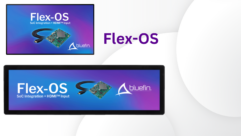Most integrators simply think of digital signage as place-based screens solely used to convey advertising or marketing information. This is understandable since the business opportunities associated with digital signage have traditionally rested with the medium’s role as an alternative to print-based materials. As a result, businesses in every sector have gone through an extensive process of replacing their print assets with digital screens. The print-to-digital transition has provided operators with an ROI by taking full advantage of today’s more effective content management systems that allow operators to target audiences and deliver more effective messages by distributing creative assets via digital signage networks.
If we take a closer look within the enterprise specifically, traditional digital signage has taken the form of either videowalls in reception areas or screens in common areas. These are great projects for integrators to take on, and advances in signage software are providing network operators with incredible flexibility and content control. However, these types of applications are just a fraction of what digital signage can provide.
Digital signage is only one of the outputs of the visual communications ecosystem. Integrators need to think beyond the passive screen and look at how visual communications solutions can provide valuable and measureable benefits to a wide variety of business units within the entire enterprise. The traditional place-based screen can now be supplemented, if not overshadowed, by a large variety of visual solutions delivered to both desktop and mobile devices. Corporations can dramatically raise the communications bar by building highly focused and interactive content channels such as business intelligence dashboards, HR messaging, or innovative training solutions. These channels can be aimed at both internal and external stakeholders, and messages can be targeted to a granular level.
This is an important but dramatic shift for integrators. By embracing the idea that digital signage is just one of many channel possibilities within the enterprise, integrators can develop innovative communications product solutions that also ignite new opportunities.
It is important for integrators to appreciate the vital importance of effective communications within the enterprise. It is the key driver for creating a cohesive workforce that shares values and business objectives. Furthermore, in an era of big data, the ability to collate and pull actionable data in realtime and then distribute that content effectively gives companies an important competitive advantage.
Companies employ teams of highly skilled communications professionals who compile, edit, and distribute content to support various business units and convey information to both internal and external stakeholders. Therefore, integrators need to offer solutions that enhance productivity, help organizations meet their pressing business objectives, and provide corporate communicators more editorial and creative freedom. This means implementing a single platform that can create custom content channels, manage a variety of content types, and control distribution. No matter if staff located anywhere in the world are using a desktop or a mobile device, the mission-critical content they need right now will always be available.
Channels can be fully interactive and provide measureable usage information. For example, integrators can work with their enterprise clients to create a specific finance channel that pulls live data directly from corporate databases, visualizes the data in a compelling presentation, and then distributes the content to any screen. These business intelligence channels can be highly targeted where specific data is sent to specific audiences and where more general financial content can be shared with other groups. By using advanced content management systems, the client can pick and choose which data to distribute and can reformat the look and feel of the channel to suit any audience. If viewers want to interact with the finance executives, the channel can be used to facilitate a live videoconference. Or if the team would like to share ideas via an internal social media network, comments can be easily added and distributed.
The same can be done with virtually any content type within the enterprise. From marketing to plant operations, every department can create highly focused channels that serve their specific business needs. These channels can feature existing content from SharePoint, Oracle, SAP, or any internal database. Content can also stem from PowerPoint, Excel, animation files, video clips, or images. Furthermore, external data content can be fully integrated to include RSS feeds, market data, social media, news, and weather information.
Integrators must focus their attention on the communications challenges that corporations are experiencing and devise solutions that bring their clients value and relieve pain points. A single, enterprise-wide platform that can drive multiple channels featuring multiple content types targeting a variety of audiences on multiple devices will both redefine corporate communications and provide integrators with rewarding business opportunities.
Vern Freedlander is vice president of production services for Montréal-based X2O Media, a leading software developer of realtime visual communication solutions that significantly improve communications throughout the enterprise. With more than 20 years of broadcast television experience as a producer, director, and executive, Freedlander oversees all of X2O Media’s content initiatives. He can be reached at [email protected].










